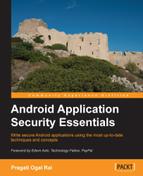Book Description
Security has been a bit of a hot topic with Android so this guide is a timely way to ensure your apps are safe. Includes everything from Android security architecture to safeguarding mobile payments.
- Understand Android security from kernel to the application layer
- Protect components using permissions
- Safeguard user and corporate data from prying eyes
- Understand the security implications of mobile payments, NFC, and more
In Detail
In today’s techno-savvy world, more and more parts of our lives are going digital, and all this information is accessible anytime and anywhere using mobile devices. It is of the utmost importance that you understand and implement security in your apps that will reduce the likelihood of hazards that will wreck your users' experience.
"Android Application Security Essentials" takes a deep look into Android security from kernel to the application level, with practical hands-on examples, illustrations, and everyday use cases. This book will show you how to overcome the challenge of getting the security of your applications right.
"Android Application Security Essentials" will show you how to secure your Android applications and data. It will equip you with tricks and tips that will come in handy as you develop your applications.
We will start by learning the overall security architecture of the Android stack. Securing components with permissions, defining security in a manifest file, cryptographic algorithms and protocols on the Android stack, secure storage, security focused testing, and protecting enterprise data on your device is then also discussed in detail. You will also learn how to be security-aware when integrating newer technologies like NFC and mobile payments into your Android applications.
At the end of this book, you will understand Android security at the system level all the way to the nitty-gritty details of application security for securing your Android applications.
Table of Contents
- Android Application Security Essentials
- Table of Contents
- Android Application Security Essentials
- Credits
- Foreword
- About the Author
- About the Reviewer
- www.PacktPub.com
- Preface
- 1. The Android Security Model – the Big Picture
- 2. Application Building Blocks
- 3. Permissions
- 4. Defining the Application's Policy File
- 5. Respect Your Users
- 6. Your Tools – Crypto APIs
- 7. Securing Application Data
- 8. Android in the Enterprise
- 9. Testing for Security
- 10. Looking into the Future
- Index
